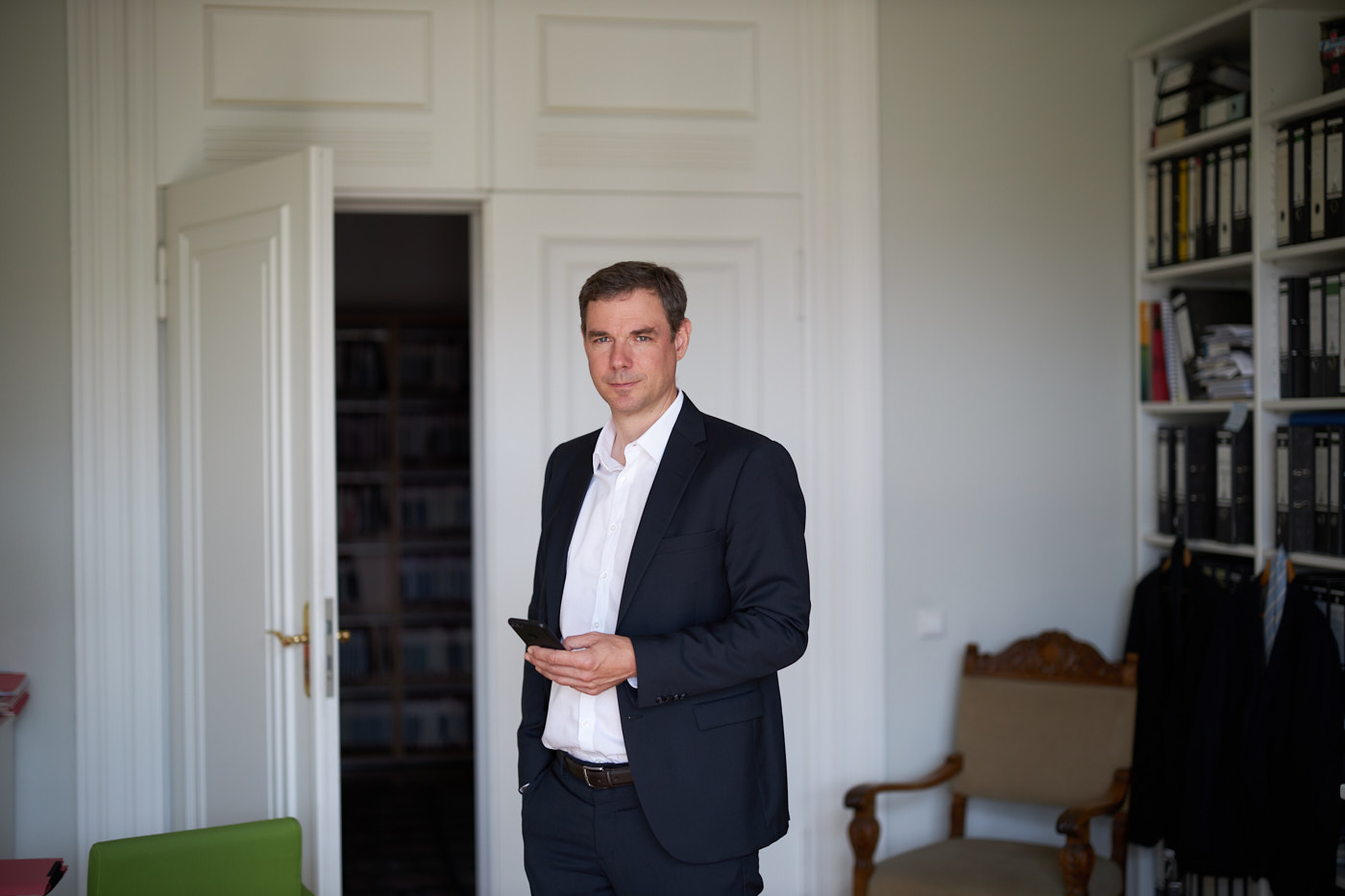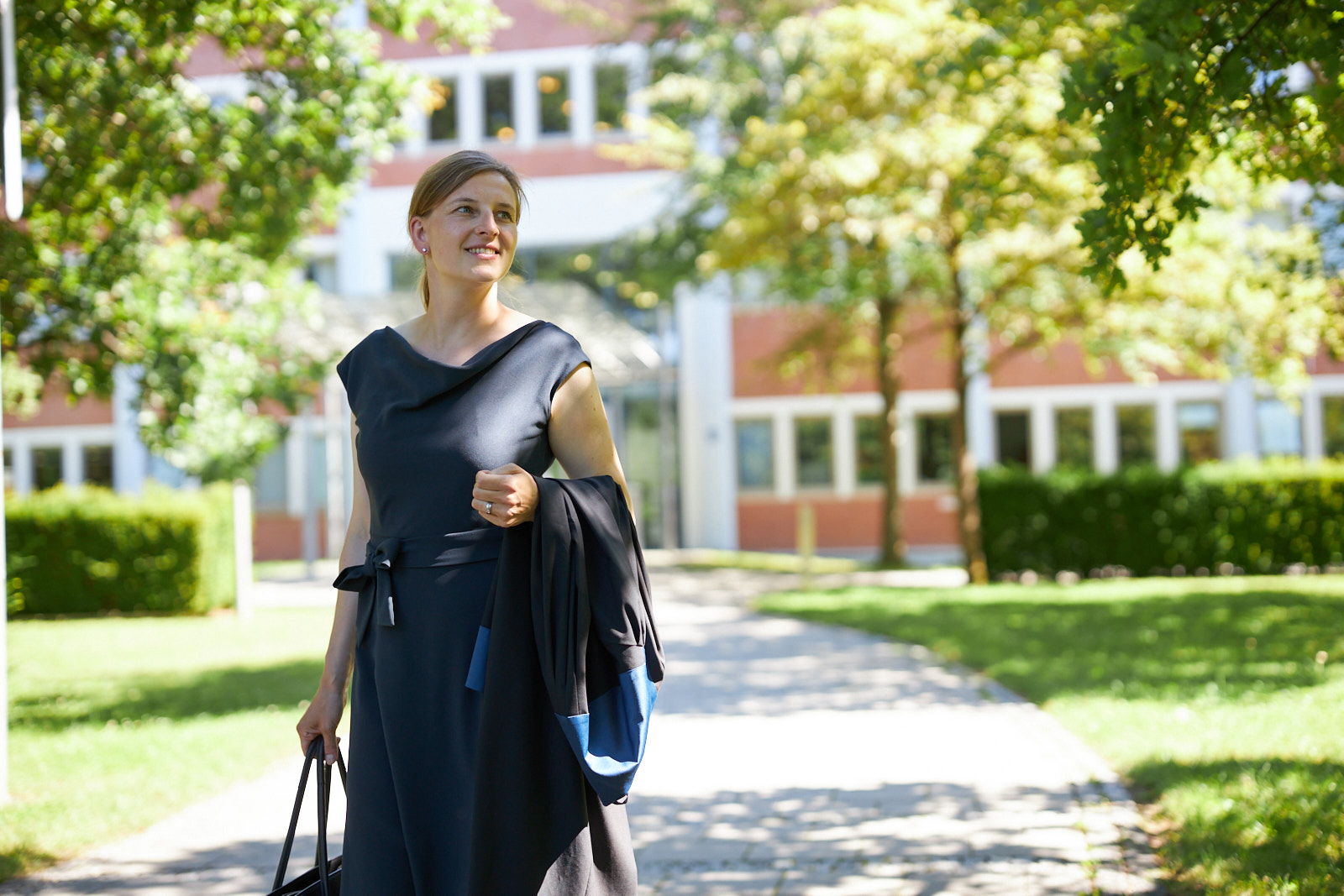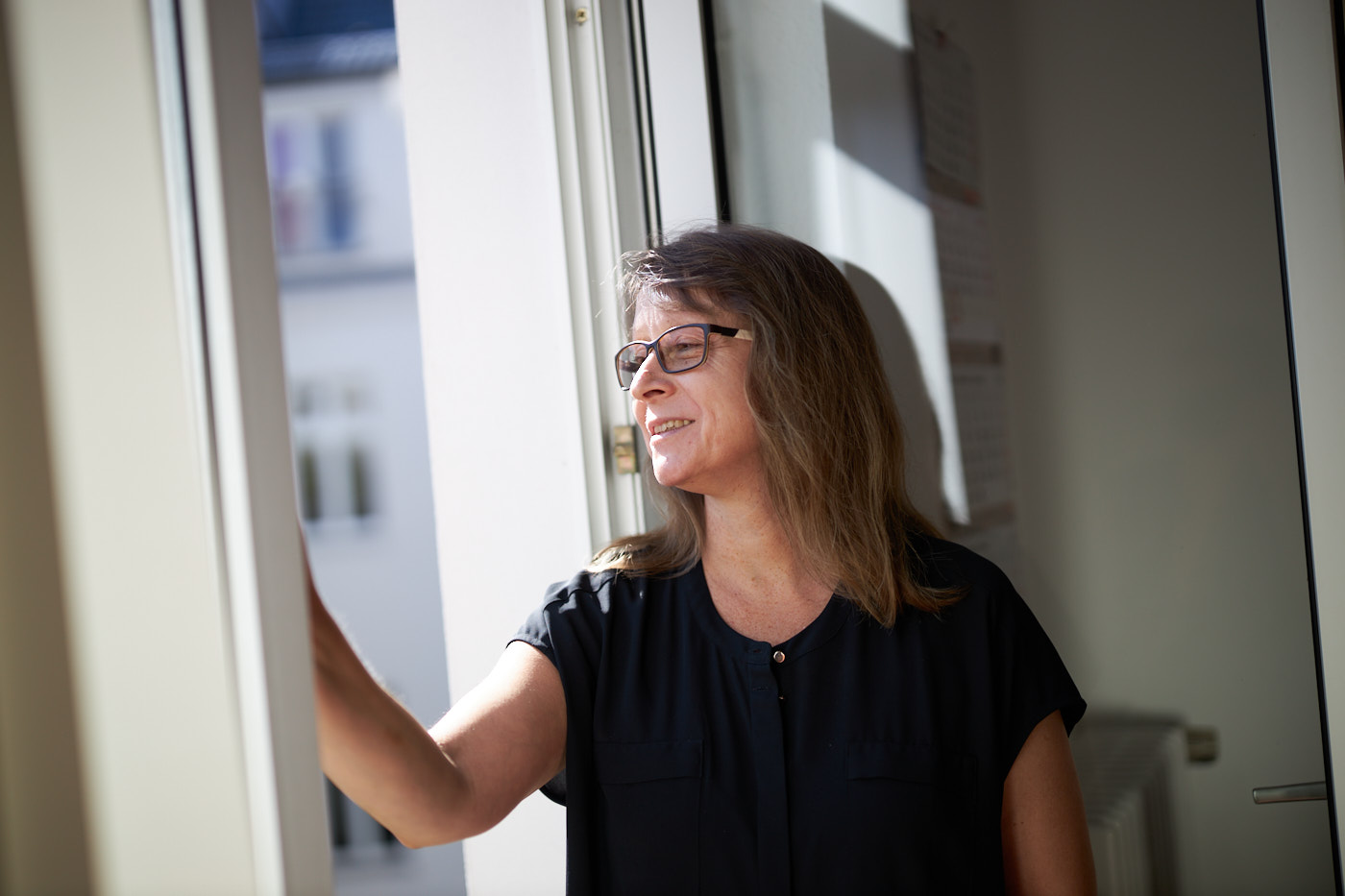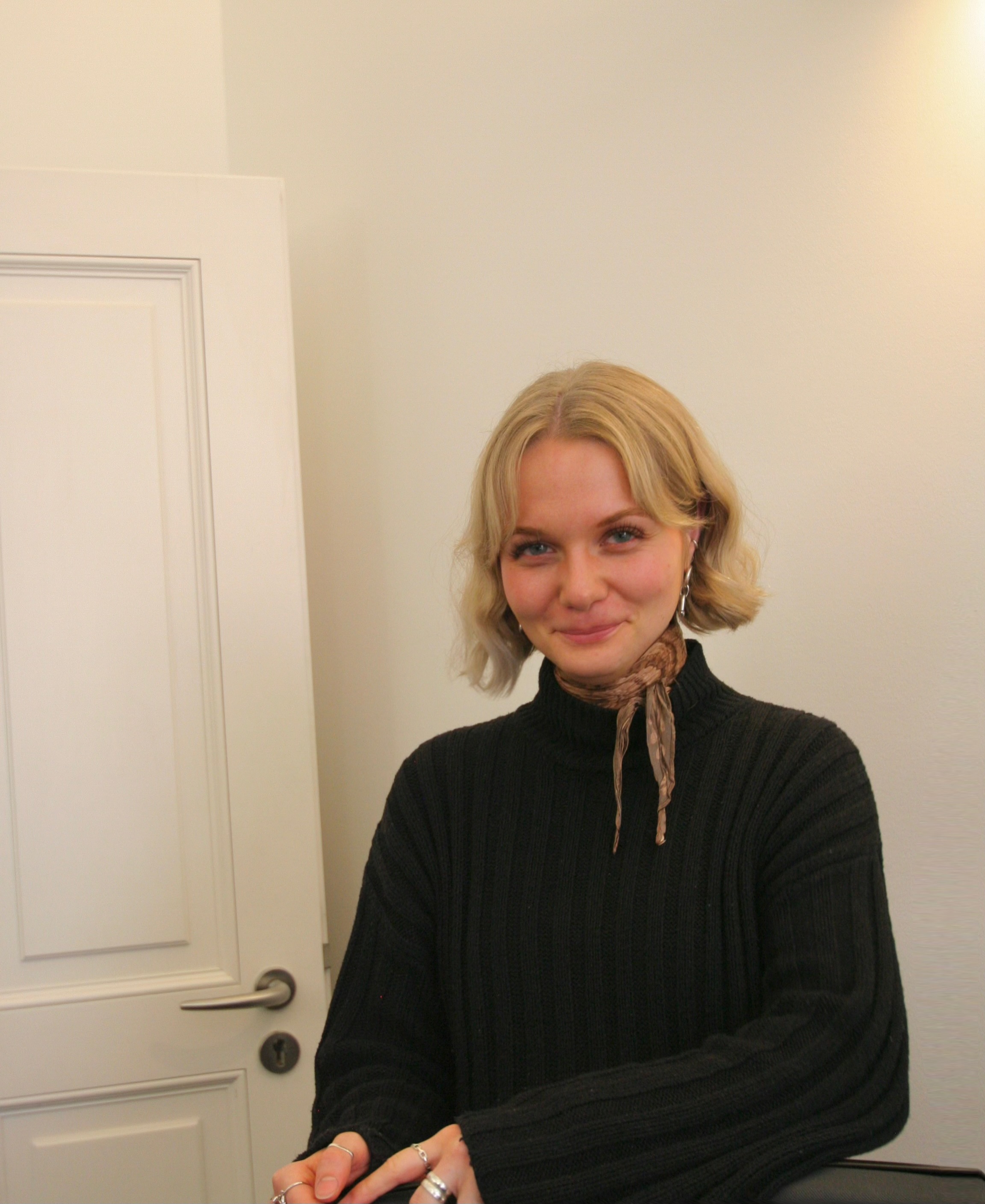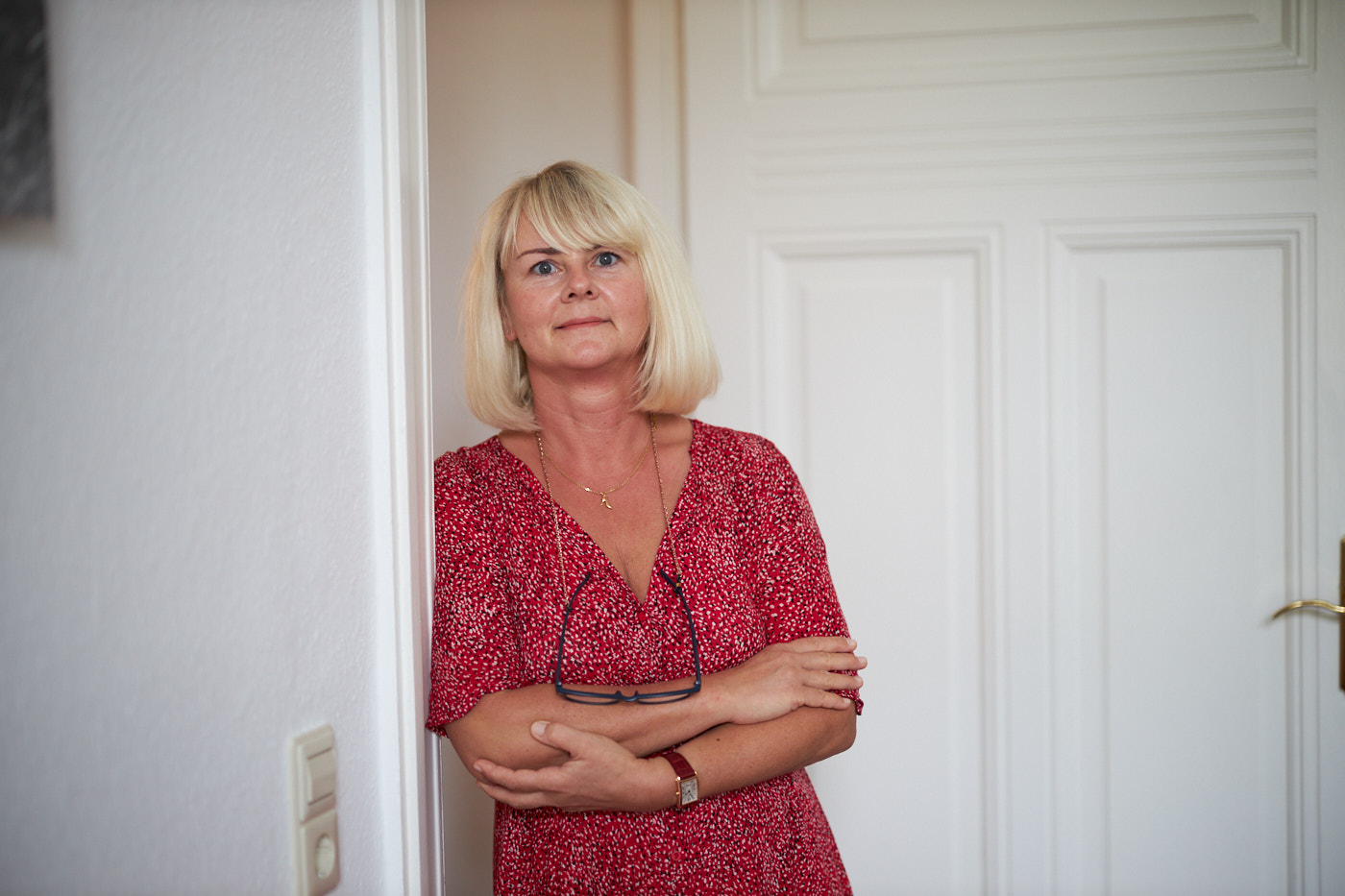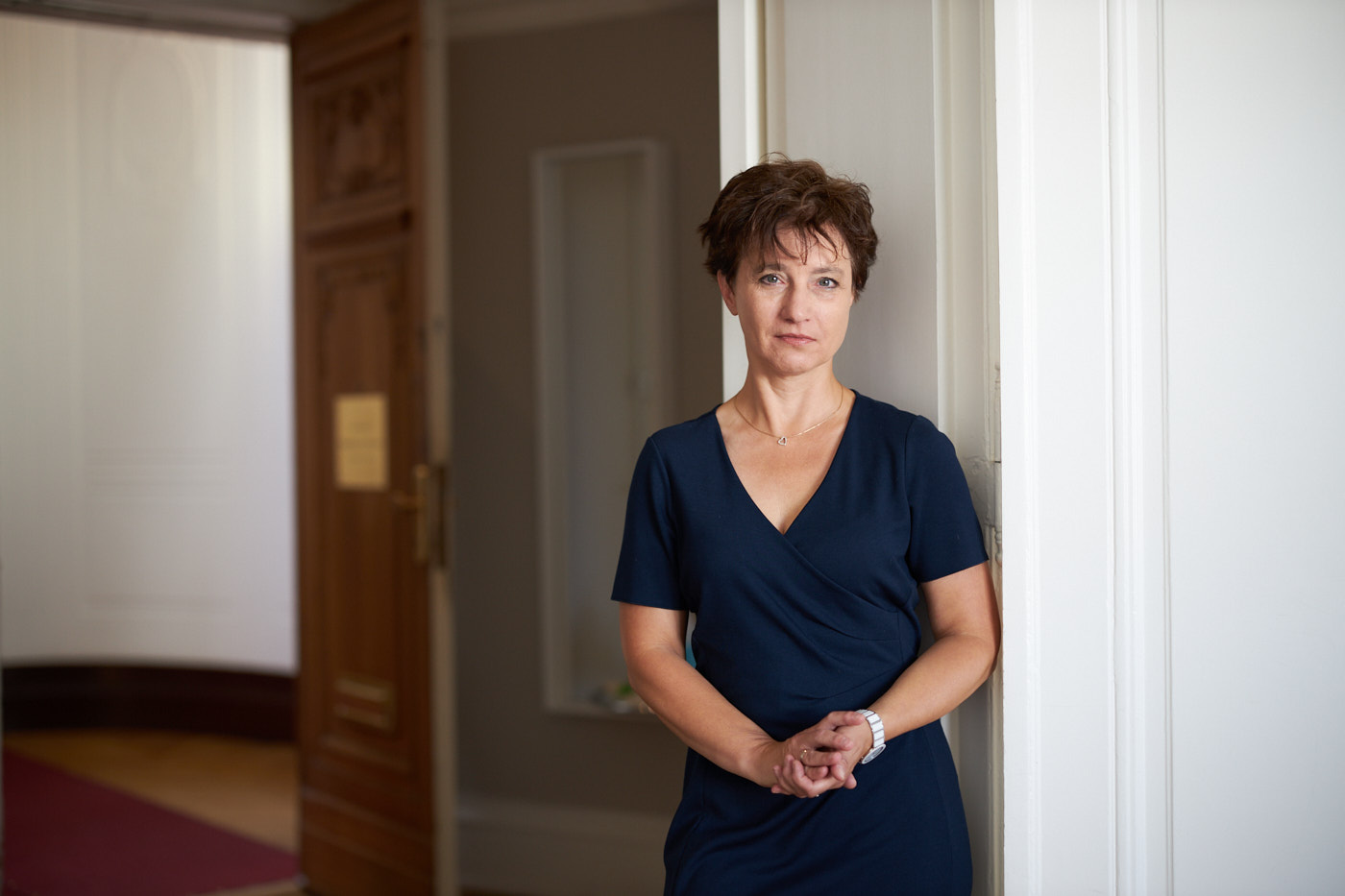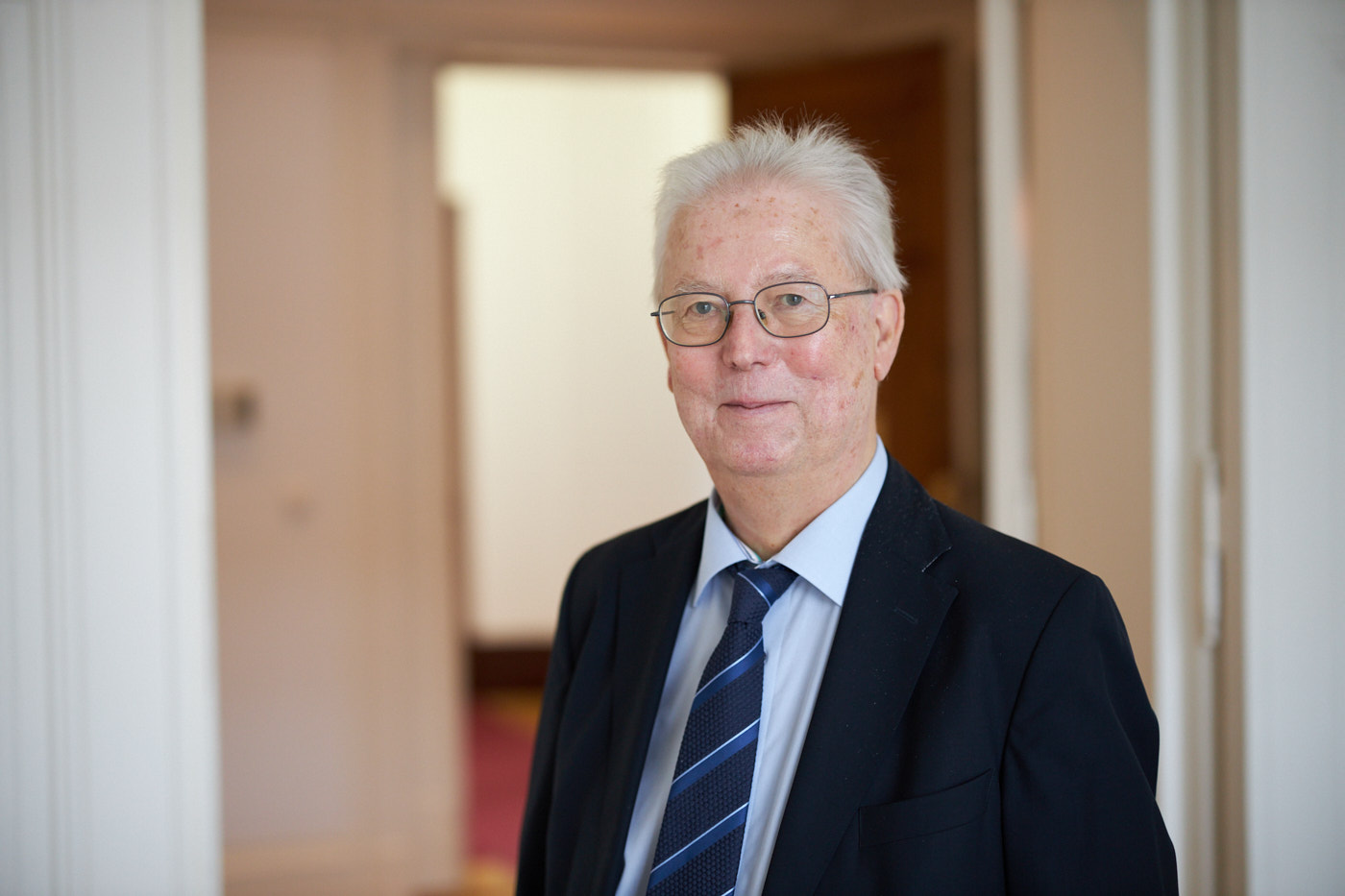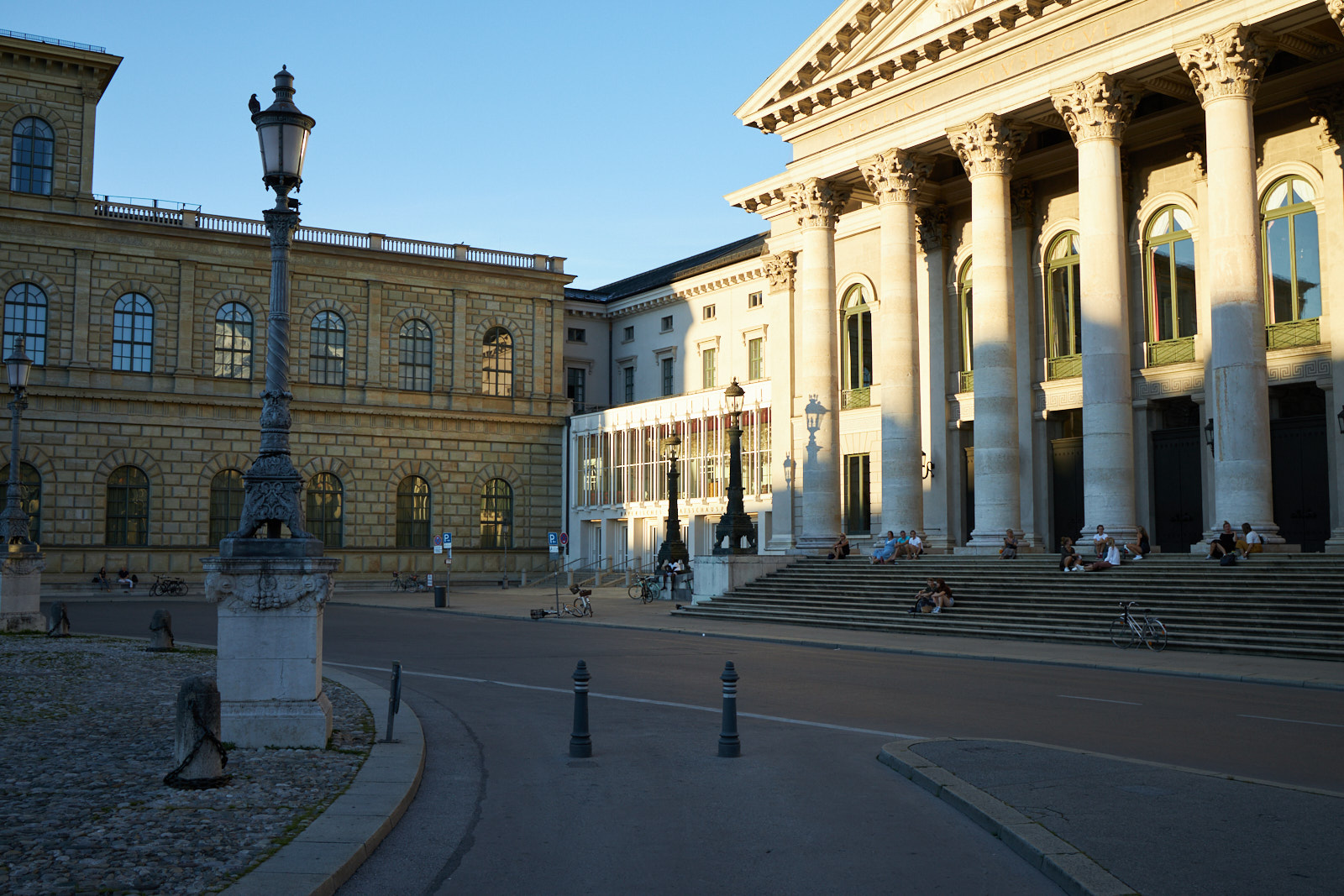
Law
Unitary Patent and Unified Patent Court
Law
Unitary Patent and Unified Patent Court
Introduction
Patent protection in Europe is on the verge of upheaval. The introduction of the European patent with unitary effect (Unitary Patent) and the Unified Patent Court (UPC) are intended to increase legal certainty at the European level and make patent protection more efficient and cost-effective.
The Administrative Committee of the UPC published a timetable in December 2022, according to which the UPC is to start work on 01 June 2023. Prior to this, on the 01 January 2023, a transitional phase in which both patent applicants and patent owners will have to make fundamental decisions will begin.
Legal Framework
The creation of Unitary Patent protection in Europe has arisen from enhanced cooperation under Article 20 TEU. Within the framework of enhanced cooperation, member states of the European Union may cooperate outside the exclusive competences of the Union in order to achieve greater integration. Regulations (EU) No. 1257/2012 (creation of Unitary Patent protection) and (EU) No. 1260/2012 (translation arrangements) serve as the basis for enhanced cooperation in the field of patent protection in Europe.
The supplementary Agreement on a Unified Patent Court (UPCA) provides the basis for the establishment of a common court (Unified Patent Court - UPC) for disputes concerning Unitary Patents as well as European patents without unitary effect (classical European patents). The UPC was signed in February 2013 by all EU member states except Croatia, Poland and Spain. It is not possible for states outside the EU to join the UPCA.
A. Unitary Patents
The European patent with unitary effect (Unitary Patent) is intended to simplify patent protection within the European Union and to enable uniform patent protection in the participating states. Unlike classical European patents, Unitary Patents can only be restricted or declared invalid with regard to all participating member states. This is intended to increase legal certainty in the participating states and prevent parallel lawsuits in different countries, which regularly occur with European patents. The Unitary Patent will coexist with the classical European patent.
I. Application for a Unitary Patent
The application for a Unitary Patent does not differ from the known application procedure for a classical European patent.
Any application must be filed with the European Patent Office (EPO) and is handled in accordance with the European Patent Convention (EPC) until the patent is granted. Once a European patent has been granted, the applicant now has the option of filing a request for unitary effect within one month of publication of the patent. In the states participating in the UPC, the procedure initiated by this request replaces the existing system of national validation of the European patent.
II. Costs of a Unitary Patent
The new system also strives to reduce costs and simplify maintenance for patent owners.
The Unitary Patent offers savings compared to a classical European patent, provided that the aim is to obtain and maintain patent protection in more than three participating states. Another advantage is the simple maintenance in the case of the Unitary Patent. The renewal fees for maintenance are to be paid to the EPO in a single payment. This is a clear simplification compared to classical European patents, for which the renewal fees have to be paid to different national patent offices in different currencies.
III. Territorial Scope of a Unitary Patent
Unlike the European Patent Convention (EPC), the Unitary Patent, which was created within the framework of enhanced cooperation, is only accessible to member states of the European Union. The maximum coverage to be achieved thus corresponds to the 27 current member states of the European Union. Croatia, Poland and Spain have not signed the Agreement on a Unified Patent Court (UPCA), which is why unitary protection for 24 countries can be expected in the foreseeable future. In some countries, however, ratification of the UPCA is still pending. Initially, protection is expected in 17 countries.
Participants at the launch of the UPCA:
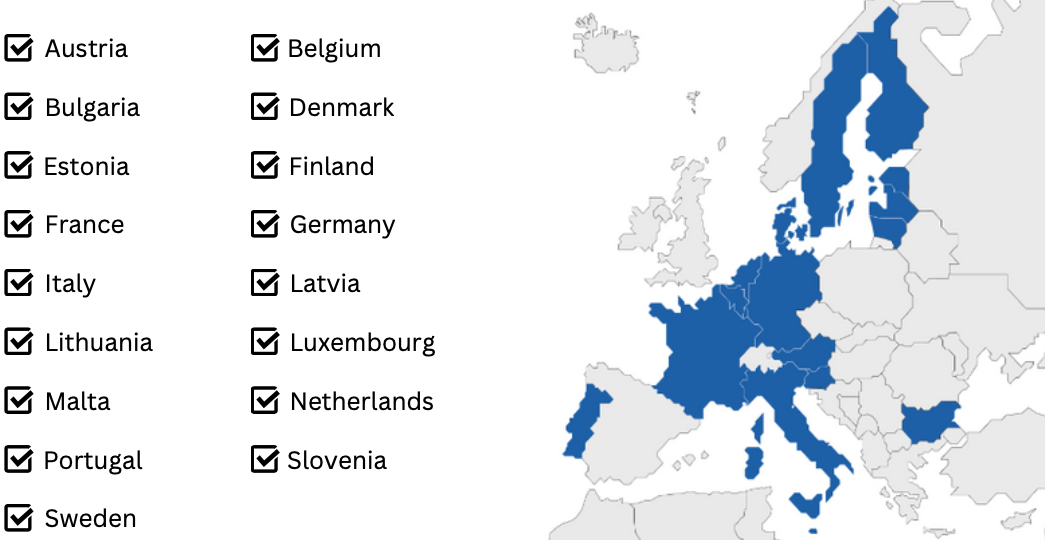
B. Transitional Measures
I. Patent Applications
In order to enable an early use of the Unitary Patent within the framework of a regulated transition, the EPO has adopted various transitional measures for European patent applications. These transitional measures will enter into force on 01 January 2023. The transitional measures concern patent applications that have reached the final stage of the grant procedure, i.e. for which a communication has been issued under Rule 71 (3) EPC.
1. Early Request for Unitary Effect
Provided that the time limit specified in the communication under Rule 71 (3) EPC does not expire more than one month before the entry into force of the UPCA, an early request for unitary effect may be filed for the patent application. If the application meets the requirements for registration of unitary effect, it will be registered by the EPO after the start of the Unitary Patent System.
Early requests for unitary effect must be filed online with the EPO.
The following example shows how the unitary effect can still be achieved for the patent if the communication under Rule 71 (3) EPC is received in January 2023:
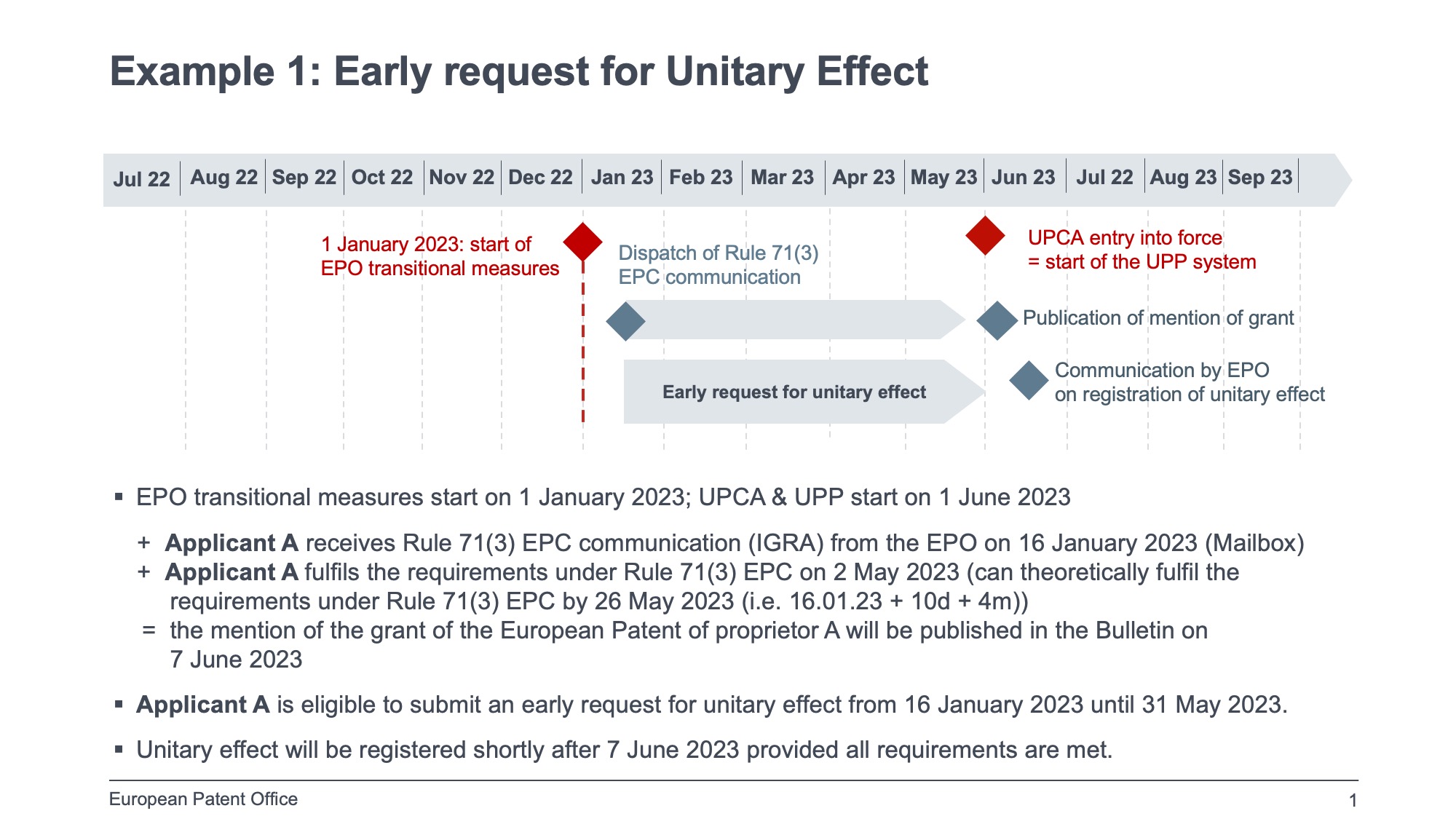
2. Request for a Delay in Issuing the Grant Decision
Provided that the period referred to in Rule 71 (3) EPC ends more than one month before the EPC comes into force, a request for a delay in issuing the grant decision may be filed for the patent application. This aims to ensure that the patent is not granted until after the entry into force of the UPCA. Then, in order to achieve unitary effect, a request for grant of unitary effect can be filed.
Requests for a delay in issuing the grant decision must be filed online with the EPO.
The following example shows how unitary effect can still be achieved for the patent if the communication under Rule 71(3) EPC is received in September 2022:
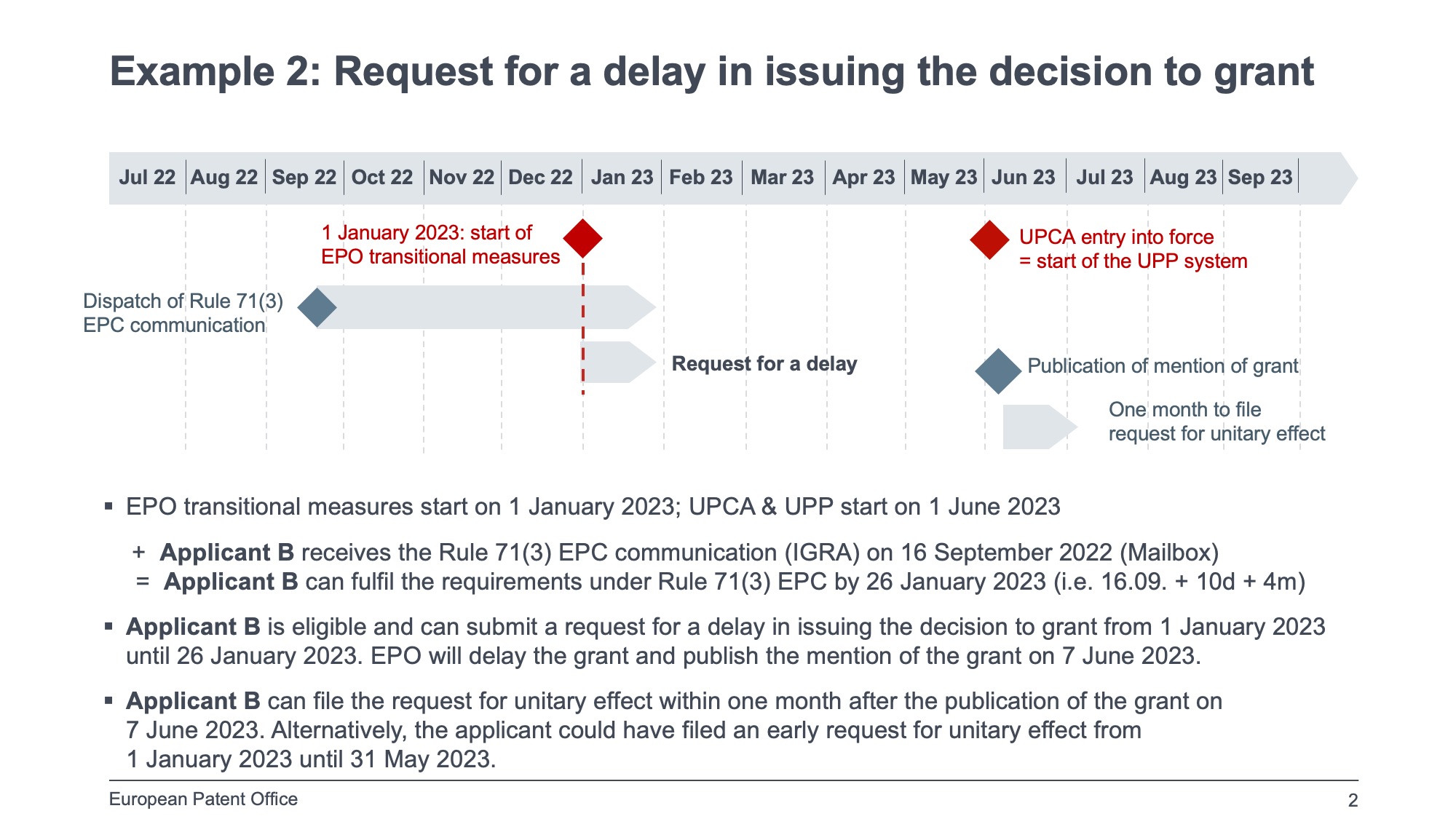
In the event that the time limit for the communication under Rule 71 (3) EPC ends shortly before the start of the transitional measurements, it is possible to request an amendment of the documents on which the grant of the patent is based by the European Patent Office. In this case, a new communication under Rule 71 (3) EPC would be issued with a new time limit, thus opening up the possibility of requesting unitary protection under one of the transitional measures described above.
II. Existing European Patents
According to Art. 83 (1) UPCA, there is a transitional period of at least seven years (extendable by a further seven years) during which actions for infringement or nullity proceedings regarding a classical European patent may continue to be brought before national courts. Thus, during this transitional period, the UPC does not have exclusive jurisdiction for classical European patents (in contrast to Unitary Patents, for which the UPC has exclusive jurisdiction).
1. Opt-out
For existing classical European patents and classical European patents applied for or granted before the end of the transitional period, there will be the possibility of an opt-out under Art. 83 (3) UPCA. With an opt-out, the jurisdiction of the UPC for a classical European patent can be excluded. However, an opt-out is no longer possible if the patent is or was the subject of proceedings before the UPC.
It will be possible to file opt-out requests three months before the UPCA enters into force, i.e. from 01 March 2023. The corresponding request must be filed with the UPC and not with the EPO. It is also important to note that there is the possibility of withdrawing from the opt-out ("opt-in"). However, an opt-in is no longer possible if the patent is or was the subject of proceedings before a national court.
Whether it makes sense to declare an opt-out is genereally a case-by-case decision, in which Maikowski & Ninnemann will be happy to assist you.
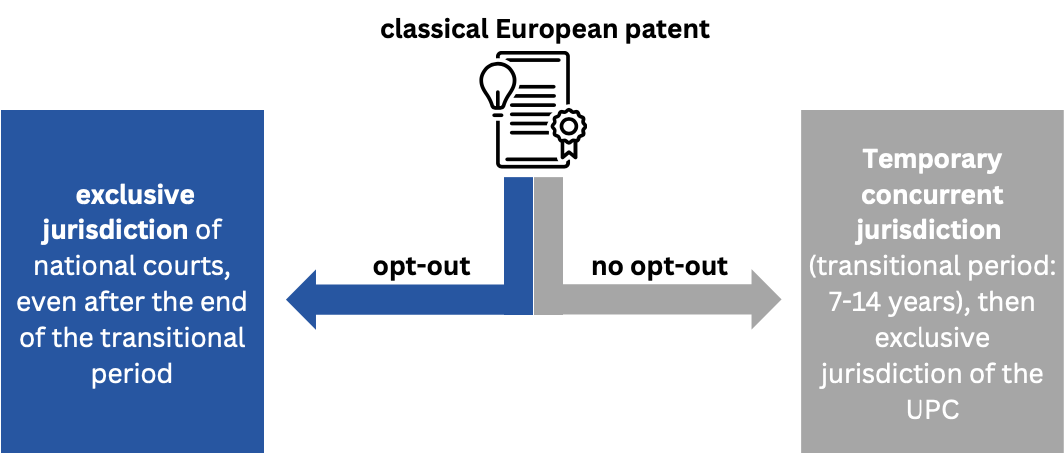
2. Prohibition of Double Patenting
Both when deciding on the filing of a request for unitary effect and when declaring an opt-out, special regulations must be observed with regards to the so-called prohibition of double protection.
Up to now, a national German patent becomes invalid to the extent that it protects the same invention as a classical European patent granted in parallel. In contrast, a national German patent can be fully effective in parallel with a European patent with unitary effect (Unitary Patent). The prohibition of double protection, which renders a German patent ineffective to the extent of the scope of a parallel classical European patent, therefore does not apply in such a case. However, the prohibition of double protection continues to apply with respect to a German patent and a European patent granted in parallel for which an opt-out has been declared. This also holds in cases where a German patent has already become ineffective due to the prohibition of double protection, regardless of the declaration of an opt-out.
As a rule of thumb, if the Unified Patent Court has jurisdiction over a European patent, a national German patent granted after the entry into force of the UPCA is valid in parallel; the prohibition of double protection does not apply. If, on the other hand, the national German courts and not the Unified Patent Court have jurisdiction for a classical European patent, the prohibition of double protection applies as before.
C. The Unified Patent Court
The Unified Patent Court (UPC) will be the first civil court at European level with decision-making competence for all participating member states. The aim of the UPC is to ensure legal certainty and to enable faster decisions on patent disputes. The UPC is expected to start on 1 June 2023.
I. Competence of the Court
The UPC will have jurisdiction to decide disputes concerning European patents with unitary effect (Unitary Patents) as well as classical European patents (for which no opt-out has been declared).
The UPC has exclusive jurisdiction for disputes relating to Unitary Patents (Art. 32 (1) UPCA). For classical European patents, there is concurrent jurisdiction between the UPC and national courts for a transitional period of seven years (extendable to 14 years), cf. Art. 83 (1) UPCA. The UPC has no jurisdiction over national patents.
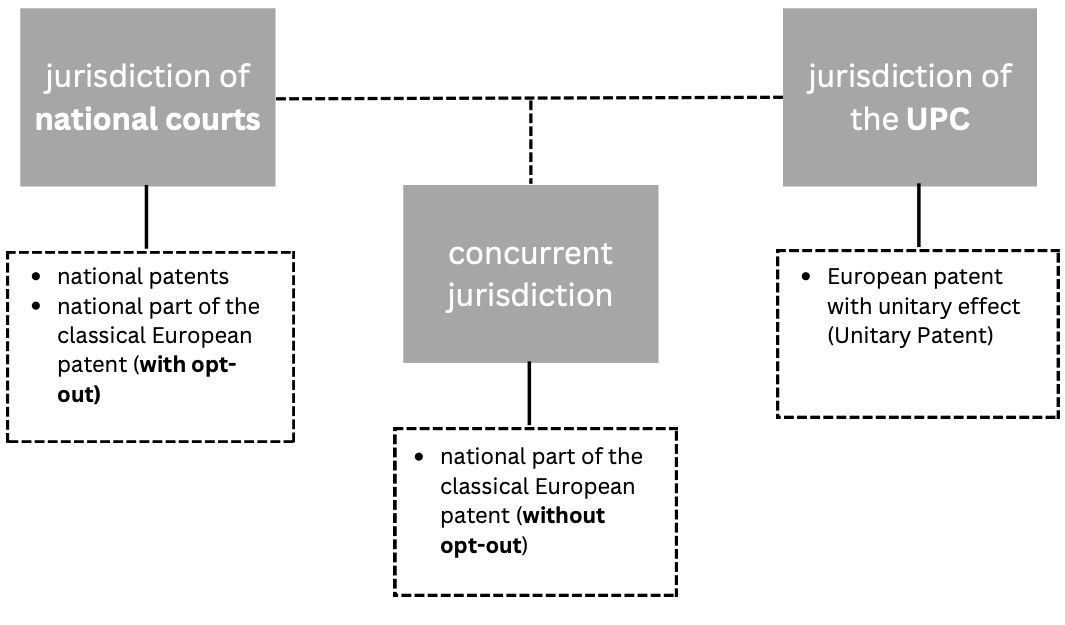
II. Structure of the Court
The structure of the court is set out in Art. 6 et seq. UPCA. The court consists of a Court of First Instance, a Court of Appeal and a Registry. The Court of First Instance comprises a central division, local divisions and regional divisions.
Each panel of the Court of First Instance is multinational in composition and consists of three judges. The panels of the local and regional divisions are composed of three legally qualified judges, with the possibility of adding a technically qualified judge to each panel at the request of either party. The panels of the central divisions shall be composed of two legally qualified judges and one technically qualified judge.
The panels of the Court of Appeal are also multinational and each consists of five judges, including three legally qualified judges and two technically qualified judges.
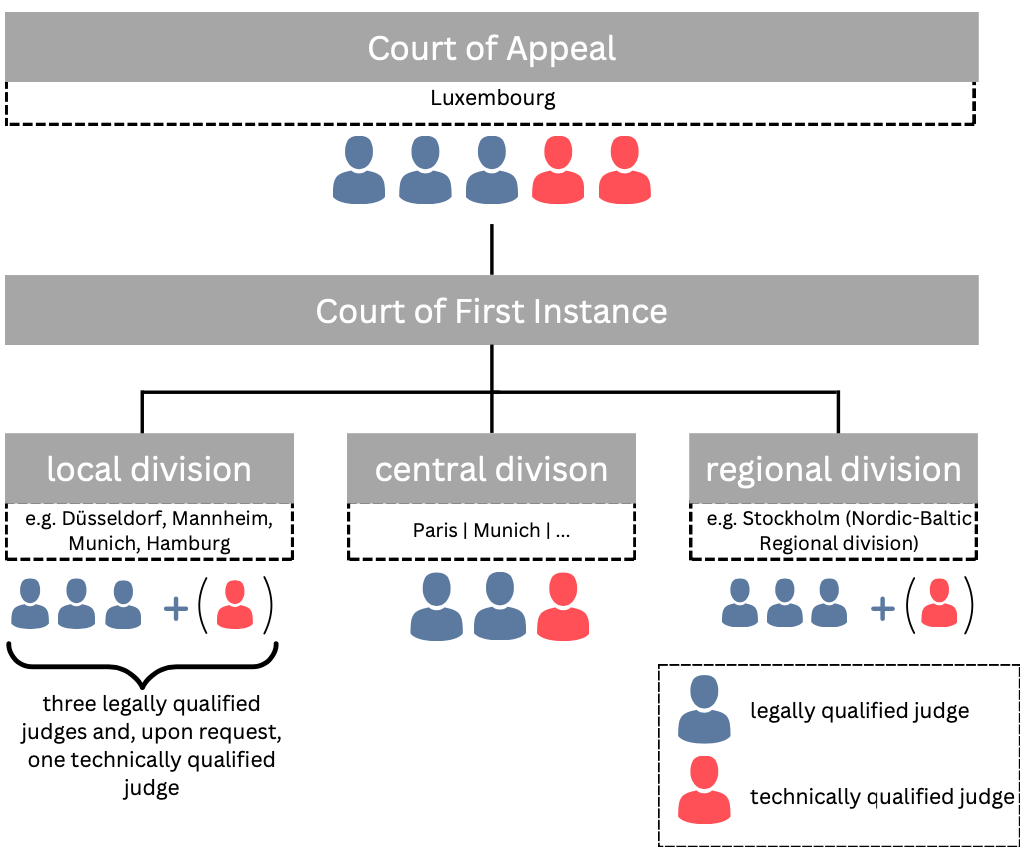
D. Rules of Procedure
I. Proceedings before the UPC
Pursuant to Art. 52 (1) UPCA, proceedings before the UPC comprise a written procedure, an interim procedure and an oral procedure.
The jurisdiction of the divisions of the Court of First Instance is based on the territory of the actual or threatened infringement or the location of the domicile or principal place of business of the defendant, cf. Art. 33 (1) UPCA. In addition, it is also possible for the parties to agree on the jurisdiction of a divsion of their choice (incl. the central division).
II. Duration of Proceedings before the UPC
The Rules of Procedure of the Unified Patent Court (UPC-RoP) lay down the time limits for the various proceedings. Written proceedings at the UPC should take place within 6-7 months. Maikowski & Ninnemann will be happy to advise on how the familiar process of written proceedings could now change.
The interim proceedings following the written proceedings serve, among other things, to prepare the oral proceedings and are to be concluded within 3 months according to Rule 101 (3) UPC-RoP.
The oral proceedings shall normally take place within one year after the commencement of the infringement proceedings according to point 7 of the preamble UPC-RoP.
III. Written Procedure
The course of written infringement proceedings before the UPC, including the time limits to be observed, is outlined below.
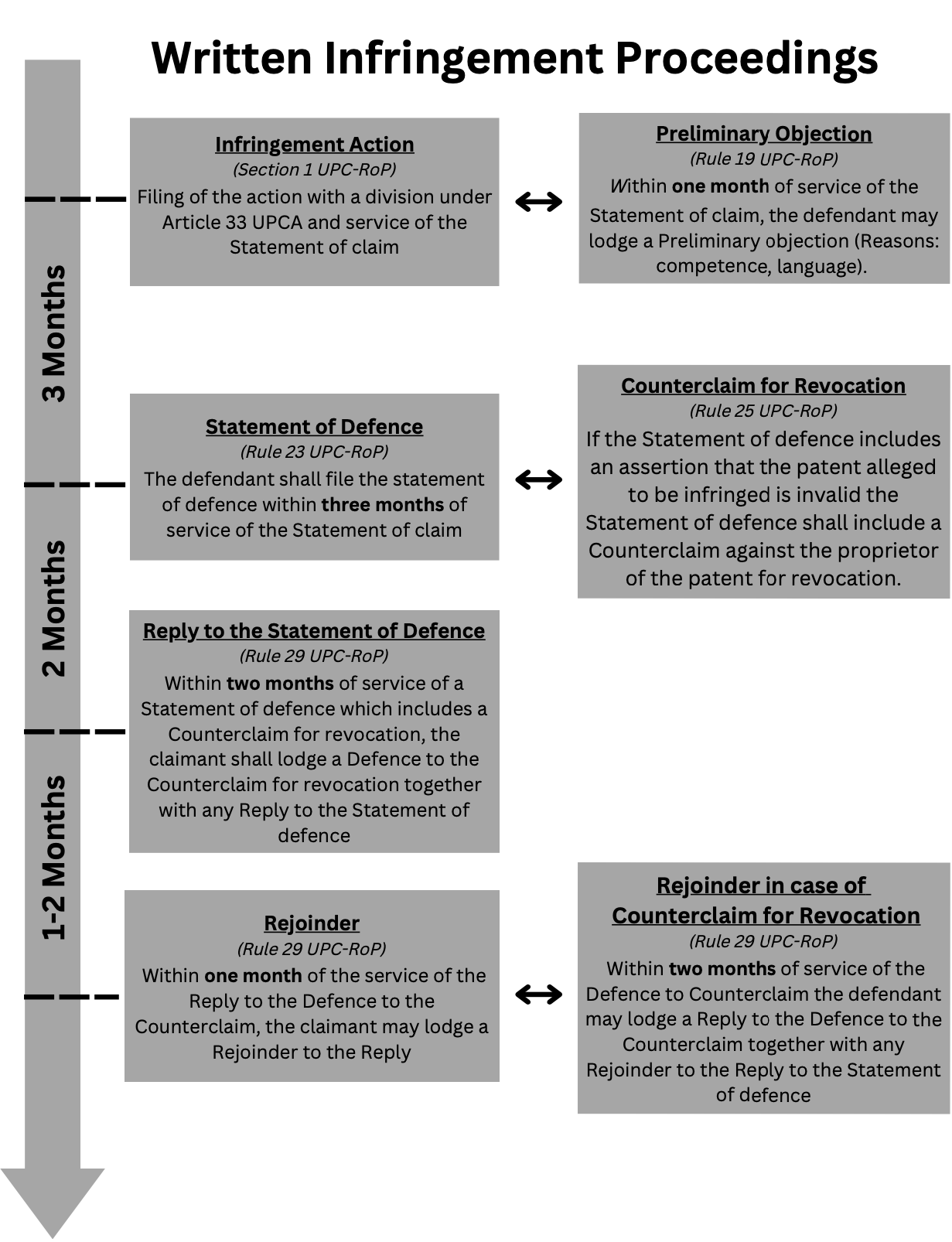
IV. Interim Procedure
The interim procedure takes place following the written procedure. The aim of the interim procedure is to make complete necessary preparations for the oral hearing.
Interim proceedings are chaired by a judge-rapporteur. According to Rule 101 (3) UPC-RoP, the duration of the interim procdure is limited to a maximum of 3 months.
In the course of the interim proceedings, the judge-rapporteur may decide to hold an interim conference. Pursuant to Rule 105 (1) UPC-RoP, this hearing shall be held by telephone or video conference, if possible, and shall be recorded in accordance with Rule 106 UPC-RoP.
V. Oral Procedure
The final stage of the proceedings shall be held in the form of an oral hearing. The oral hearing shall be chaired by the presiding judge of the division and, pursuant to Rule 113 (1) UPC-RoP, shall not last longer than one day. The oral hearing shall be held in public, unless it is in the interest of one of the parties or third parties or in the general interest of justice or public order to make it confidential, cf. Rule 115 UPC-RoP.
Following the hearing, the court shall render a decision on the merits as soon as possible and shall set it down in writing within six weeks (Rule 118 (6) UPC-RoP).
Proceedings and decisions of the court regarding damages, claims for information or the reimbursement of procedural costs may be the subject of subsequent procedural steps.
Attorneys
-
Visit Profile

Gunnar Baumgärtel
Berlin
Patent Attorney, European Patent and Trademark Attorney, LL.M., UPC Representative
-
Visit Profile

Ralf Emig
Berlin
Patent Attorney, European Patent and Trademark Attorney, UPC Representative
-
Visit Profile

Felix Gross
Berlin
Patent Attorney, European Patent and Trademark Attorney, LL.M., UPC Representative
-
Visit Profile

Frederick Kramer
Frankfurt
Patent Attorney, European Patent and Trademark Attorney, UPC Representative
-
Visit Profile

Christoph Schröder
Berlin
Patent Attorney, European Patent and Trademark Attorney, UPC Representative
-
Visit Profile

Fabian Sokolowski
Berlin
Patent Attorney, European Patent and Trademark Attorney, UPC Representative
-
Visit Profile

Andreas Tanner
Munich
Patent Attorney, European Patent and Trademark Attorney, LL.M., UPC Representative
TECHNOLOGY




